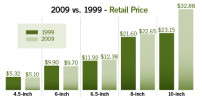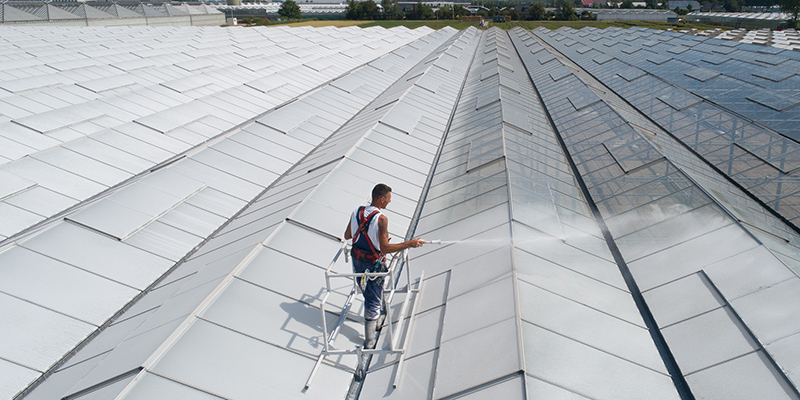In 2009, Poinsettias Persevered

Doubts about consumer spending during the holidays were understandable, but growers pulled through yet another poinsettia season in 2009 that can be described as good for many, great for some and better than most anticipated.
As one Midwestern grower serving independent garden centers put it: “The 2009 poinsettia market was very busy. We saw excellent sell-through with wholesale clients and in our retail stores. Despite the economic worries, people were still purchasing poinsettias.”
The majority of growers would agree with all or most of that sentiment. Of the 100-plus poinsettia growers we surveyed earlier this year, nearly half report sales increases over 2008. More than one-quarter report at least maintaining their 2008 sales in ’09, and less than one-quarter say they experienced sales decreases with poinsettias.
What else did growers say about poinsettia season? We reveal highlights from our 2010 Poinsettia Survey and share production and sales data we gathered in the paragraphs ahead.
Colors & Varieties
To give you an idea who we surveyed, more than 70 percent of respondents have been growing poinsettias at least 20 years, nearly two-thirds are located in either the Midwest or Northeast, and the primary customer of the majority is either independent garden centers or their own retail shop.
Growers are still purchasing their cuttings from the four major poinsettia breeders (Dömmen, Paul Ecke Ranch, Selecta First Class and Syngenta Flowers), but nearly all of them (95 percent) are at least purchasing some cuttings from Ecke Ranch.
It’s no surprise, then, that the top-selling red and novelty poinsettias for 2009 were Ecke Ranch’s. ‘Prestige’ was the top-selling red for 58 percent of growers, and ‘Freedom Red’ (13 percent) followed right behind.
The top-selling novelty, according to growers, was ‘Ice Punch,’ which 15 percent say was their best seller of 2009. Syngenta’s ‘Sonora White Glitter’ and ‘Cortez Burgundy’ were the next-best sellers.
As for colors, red is still the overwhelmingly preferred choice. We averaged the number of poinsettias being produced by color and found 74 percent are red. White (8 percent) is the second-most-produced color, followed by pink (5 percent), marble (4 percent) and other colors.
One grower we surveyed reports 30 percent of his production is whites. Another grower reports 30 percent of his production is pinks. Most growers, however, are still dabbling with the non-reds.
Pricing
A knock on poinsettias, some growers will argue, is the wholesale and retail prices received for them. We asked growers about their prices on five different pot sizes (Figures 1 and 2), and then compared those figures to the prices growers received 10 years ago. In many cases, we found average prices have not increased over the years as you might expect–especially considering inflation, higher input costs and other developments between 1999 and 2009.
The most significant find was the average wholesale price received for 8-inch poinsettias: Growers today are receiving $3.29 less for every 8-inch poinsettia than they were in 1999. Retail prices for 8-inch are slightly better today ($22.65) than they were a decade ago ($21.60). Today’s prices don’t necessarily indicate growers aren’t turning profits on 8-inch–although increasing margins would suggest they’re having more success with other sizes.
Ten-inch poinsettias are one such size. Wholesale prices received for 10-inch are 29 percent higher than they were 10 years ago. Likewise, 10-inch poinsettias are selling at retail for 30 percent more today than they were at the turn of the century.
Growers are also receiving better wholesale prices today on smaller sizes than they were in 1999, but retail numbers are down slightly with 4.5- and 6-inch and only up slightly with 6.5-inch. The lowest wholesale price reported this year on 4.5-inch poinsettias was $1, and the lowest 6- and 6.5-inch wholesale prices reported were $3. Twenty-eight dollars was the best wholesale figure received for 8-inch, and $40 was the best for 10-inch. The highest retail price reported for 10-inch, meanwhile, was $65.
“Retail customers are willing to pay for better quality and size, but mass merchandisers are resistant to stock a higher price point poinsettia,” says a Western grower.
Challenges
Poinsettias are a challenging crop because there are so many obstacles growers must overcome before their products reach retail benches. Managing greenhouse temperatures, controlling height and proper media and fertilization all keep growers busy late in the year. But the poinsettia grower’s biggest challenges in 2009 were pricing, competition and marketing.
More than one-third of growers listed pricing as their biggest poinsettia obstacle, and 13 percent of growers respectively marked competition or marketing as their No. 1 obstacle.
“With places like Lowe’s and Walmart selling 6-inch pots for $3.95, we can’t compete,” says a Southeast grower serving his own retail shop.
Markets growers listed as showing or continuing to show promise were fundraisers, churches, schools, doctor’s offices, pharmacies and larger businesses. Thinking out of the box is another way to overcome challenges and reel in high prices. Peace Tree Farm’s Christmas Tree Poinsettia (PeaceTreeFarm.com) is a case in point.
Impression
Overall, poinsettia season was above average. When we asked growers to rate the season on a scale of 1 to 10, they gave it a 6.34. The rating isn’t as high as the one respondents gave the 1999 season (8.10), but growers are leaving the door open for optimism and anticipating poinsettia opportunities in 2010.









